As I wrote in my piece about making stuff happen, owning your skills is the key to freedom, and cooking is no exception. Too many people today can’t cook a damn thing, and it shows in their health, their dependency, and the steady decay of real self-reliance.
I was reminded of this recently while listening to some folks brag about their secret squirrel ninja tactical training. You know the type: loaded with gear, zero fitness, and a membership in Meal Team Six. They have every gadget under the sun but not a shred of practical know-how for the 90% of life that actually happens. No medical or first-aid sense, no street smarts for a trip to Walmart, just cosplay survival.
I’ve written before about baking pies and desert tarts, not something I eat every day, but worth knowing how to do for special events or when guests come by. Today I want to bring it down to something simpler, a country breakfast. Bacon, pancakes, and the kind of morning that reminds you life is still good when you make it yourself.
Because this is the 90% stuff, the real-life, everyday competence that actually matters.
If you can feed yourself well, think clearly, and keep your tools (and your body) in working order, you’re already living what Kipling wrote about in If, holding your own when the world is spinning off its hinges. Real preparedness starts right here, in the small, repeatable things you can actually do.
I Smell Bacon!
I used Hormel Natural Choice Original Thick Cut Uncured Bacon for this batch. Short of visiting a local butcher and getting something truly old-school, I wanted an uncured bacon without the chemical nonsense. This one does the job. No fake smoke, no neon-pink curing salts, just honest pork that cooks the way bacon should, slow-rendering, rich, and real.
I took the whole package and cut it in half. What we didn’t eat, I’d save for later, BLT sandwiches. The half slices are easier to work with on the grill, less curling, and easier to flip cleanly.
Then I took it outside to the Blackstone griddle, because bacon deserves open air and elbow room. The key is steady heat, not high, not rushed. Let the metal do the work. The fat renders, the edges curl, and that smell hits you square in the memory. That’s when you know it’s working.
When we moved here, one of the first things I added was to a gas line from our 500 gallon propane tank. It runs the stove, the generator, the water heater, and yes, the grill. No small bottles to swap, no half-empty tanks when you need them most. Just solid, reliable fuel on tap.
And if you notice in some photos, I’m wearing a green apron that looks suspiciously like something Alfred from the 1968 Batman series would wear. That’s not for fashion. It’s because bacon grease is hot, and after enough burns, and enough grease on myself just working on the tractor , I finally learned.
The Chemistry of Bacon
Good bacon starts with good heat. I fire up the grill on high first, especially in the cold months, to get the metal up to temp. Once it’s hot, I back it down to low and let the surface settle. That preheat keeps the cooking even and the grease from pooling. Bacon hates cold steel, even if I don’t.
Cooking bacon isn’t guesswork. It’s a controlled crash of chemistry. Bacon is mostly fat with some protein and water thrown in. Start it cold and bring it up slow. Around 130°F the fat begins to render and you get that first soft sizzle. Push the heat too fast and the water flashes to steam before the fat melts, spraying grease everywhere and cooking the meat unevenly.
Bacon done right has a rhythm to it. Slow, steady, and confident. It doesn’t curl in panic or drown in grease. It just renders, browns, and waits for you to pay attention.
Next comes the Maillard reaction. That’s the browning magic where the amino acids and sugars in the meat start bonding under heat. It wakes up around 300°F and peaks around 350°F. That’s the zone where bacon turns from soft to crisp, with just enough chew left to feel right. Go much hotter and you’re not cooking bacon anymore, you’re making charcoal.
Watch the fat. It tells you everything. It should shift from white and opaque to clear and liquid without a lot of smoke. When the grease starts smoking hard, you’re too hot. Bacon fat is mostly oleic, palmitic, and stearic acids, the same mix that makes lard stable and useful. That’s why old-timers saved it.
Good bacon doesn’t need a thermometer anyway. You can tell by sound. It starts with a chatter, then drops to a low, steady hiss when it’s close to done. That’s when you turn it once, not ten times.
One more simple tip: when the bacon’s done, lay it out on a few paper towels before serving. It soaks up the extra grease and keeps everything crisp without turning the plate into an oil slick.
Grease Discipline
Bacon grease is the real treasure of breakfast. It isn’t waste; it’s fuel, flavor, and proof that you did it right. When the strips come off the grill, you’re left with what the old-timers called liquid gold. Back then, bacon grease was kitchen currency. People saved every drop and used it for everything from eggs to biscuits.
These days I don’t keep much of it. I tend to cook with butter instead. It’s cleaner, easier to manage, and doesn’t leave the place smelling like a smokehouse for a week. Still, bacon grease is worth its weight. I keep a small jar around and use it now and then to fry potatoes, brown cornbread, or season a skillet. It adds a depth you can’t fake.
If you decide to save it, pour it warm through a small metal strainer into a jar. It keeps the bits out and stores clean. Good grease smells like bacon heaven when you open it. Burn it once and it’ll smell like an old truck clutch. I’ll also use it to start burn piles or oil tools, but be careful with that, bacon grease burns hot and fast, and once it’s lit, it’s not easy to put out. Nothing goes to waste. Grease is utility, flavor when you want it, and fuel when you don’t.
Then I scrape the grill clean, some folks around here like to cook their pancakes right in that leftover grease. That’s their way. I prefer to cool the surface, clean it off, and cook my pancakes in butter. It’s just my taste.
Homemade Pancakes
After the bacon’s done and the grill’s scraped clean, it’s time for pancakes. Real ones. Around here we call them pancakes, though some folks still say flapjacks. Both mean the same thing in most of the U.S., but head across the Atlantic and a flapjack turns into a baked oat bar instead of breakfast.
Down South, pancakes have deeper roots. Before white flour was common, people made them with cornmeal and called them hoe cakes, johnny cakes, or griddle cakes. They were fast, filling, and didn’t need an oven, just a hot pan, some meal, and a little fat. The kind of food that kept farmers, loggers, and field hands moving.
One of my earliest memories is eating breakfast in the galley car of a train in the 1960s. I still remember the chef, an older Black man in a white apron, working that tiny kitchen with quiet precision. The smell of butter filled the car, and the sound of those pancakes sizzling on the griddle stuck with me for life. They were perfect: light, golden, and made by someone who clearly took pride in his craft. That morning taught me something I didn’t have words for back then, that skill and care matter more than anything on the plate.
So when I mix batter on a quiet morning, I’m not chasing nostalgia. I’m keeping a working tradition alive. Simple ingredients, cooked on a hot surface, shared with whoever’s around.
Bulk Pancake Mix
I make my own pancake mix for the same reason I fix my own tools: I like knowing what’s in it. Most store-bought mixes are full of stabilizers, preservatives, and powdered fillers that have nothing to do with real food. The ingredient list reads like something from a lab instead of a kitchen.
⅔ cup sugar
2 tablespoons arrowroot
1 tablespoon baking soda
When you mix it yourself, you control everything. The flour, the sugar, the leavening, all clean and simple. It costs less, tastes better, and stores just as long if you keep it sealed. I can make a batch for pennies and know it’ll taste right every time. That’s it. Mix it dry and store it sealed.
What Goes in the Batter
he batter’s where the magic happens. I don’t use boxed shortcuts or powdered mystery blends. Real food makes better pancakes. It’s that simple.
I start with Rumiano Organic Unsalted Butter, because butter’s flavor beats oil every time.
Then I add pumpkin puree for moisture and a touch of natural sweetness. It’s not pumpkin spice, just straight pumpkin, the way it should be.
For flavor, I mix in a splash of vanilla extract, sometimes Mexican, sometimes Madagascar, depending on what’s on hand. Each one brings a slightly different depth.
For liquid, I go with A2 milk and plain A2 organic yogurt from grass-fed cows. Both give the batter body and a bit of tang. Yogurt makes them fluffier and gives that slight buttermilk edge.
The eggs come from our own chickens, which makes a difference you can see. Rich yolks, solid whites, no guessing what went into them.
Divine Proportions
don’t measure down to the gram. This isn’t pastry school. Pancakes should be forgiving, not fussy. After enough batches, you’ll land on ratios that just work. It’s like mixing concrete or plaster, you don’t need digital scales or chef’s math, you need a feel for what looks and pours right.
Start with one cup of dry mix for every two people. Add one egg, a heaping spoon of melted butter, and about ¾ cup of A2 milk. If I’m using yogurt, I’ll split it half milk and half yogurt. Keeps it rich but still easy to pour.
Why Grass-Fed Matters?
I stick with grass-fed dairy for a reason. Corn-fed animals in the U.S. don’t just eat corn. They eat grain soaked in pesticides, often GMO, and it shows up in the final product. Those residues, along with the hormone load that comes from grain-heavy feeding, change the chemistry of the fat and protein. You need to pay attention to these things if you want to do any type of hormone optimization in your diet.
There are higher levels of estrogenic compounds in milk from feedlot systems compared to pasture-raised cows. You won’t hear much about it, too many hands in the feed bucket. Big dairy, Big Ag, and Pharma all keep quiet because the system runs on cheap corn. Congress has subsidized it for decades, turning it into the foundation of everything from cattle feed to soda syrup.
I’m not buying it. Grass-fed cows eat what they’re meant to eat. The milk’s cleaner, the fat behaves right, and the flavor tells the truth.
Corn: The Hidden Ingredient
Most people don’t realize how deep the corn rabbit hole goes. For decades, U.S. farm policy has poured billions into corn subsidies. It’s not just about ethanol or feed, it’s the backbone of cheap calories. Corn turns into everything: cattle feed, high-fructose syrup, cooking oil, and even packaging.Feedlots run on it because it’s cheap, not because it’s good for the animals or for us. Grain-fed cows get fatter faster, but their fat profile shifts, more omega-6, fewer omega-3s, and a higher load of hormone and pesticide residues. The same story plays out in the dairy aisle and the drive-thru window.
The result? A nation that eats more corn than it realizes, one step removed and labeled as something else. Grass-fed isn’t a trend; it’s a return to how food’s supposed to work.
Once you’ve got clean ingredients, the rest is just chemistry and common sense. Butter, yogurt, pumpkin, vanilla, each one pulls its weight for a reason.
Why the Butter?
Butter’s where the soul of the pancake lives. It’s not just fat; it’s a mix of milk solids, water, and flavor compounds that change everything when they hit the heat. The milk solids brown first, giving that nutty, toffee edge you smell right before the batter hits the griddle. Butter also coats the flour proteins, keeping gluten from tightening up too much, so pancakes stay tender instead of rubbery.I use Rumiano Organic Unsalted Butter, melted right before mixing. Unsalted gives you control. Add it warm, not hot, or you’ll thicken the batter before you’re ready.
Why the Yogurt?
Yogurt brings acidity, fat, and body, all things that make better pancakes. The acid reacts with baking soda to lift the batter naturally and tighten the starch and protein for a soft but stable crumb. It’s the same chemistry that makes buttermilk pancakes good, just cleaner.Yogurt’s also an emulsifier, helping fat and water stay mixed for an even crumb. I use plain, whole-fat A2 organic yogurt from grass-fed cows. It plays nice with butter, adds balance, and if your mix goes dry, a spoonful or two will smooth it out fast.
Why the Pumpkin?
Pumpkin adds moisture, natural sugars, and a bit of pectin, which helps the batter hold air and stay tender. The sugars boost the Maillard reaction, that golden browning magic, while the mild acidity fine-tunes the crumb. It’s subtle, not sweet, not “pumpkin spice latte” (those don’t even have pumpkin in them), just a warm, earthy tone that makes everything taste grounded.
Why the Vanilla?
Vanilla’s the quiet workhorse. Its main compound, vanillin, reacts with fats and sugars to round out sharp flavors and bring the batter together. It doesn’t make things taste like vanilla, it makes everything else taste complete. One teaspoon’s plenty. Any more, and it starts to boss the rest around.
Into the Mix
Once everything’s in place, it’s time to bring it together. I mix everything by hand with a whisk. No blender, no stand mixer, just a bowl, a whisk, and a little patience. A whisk gives you control and feel. You can see how the batter thickens, how the bubbles form, and you don’t end up overworking it.
A blender might make things faster, but it also beats the batter flat and loads it with air you don’t want. Pancake batter should be smooth, not whipped. And when you’re done, the whisk rinses clean in ten seconds. No disassembly, and it’s a lot easier to clean up.
The goal isn’t perfection, it’s consistency. You want it to pour like heavy cream, not like glue. If it clings to the whisk and falls off in ribbons, you’re in the zone.
I am reminded of Amos Burton from The Expanse. He figured it out. No speeches, no theory, just do the work right and stay steady while everyone else panics. Mixing batter’s not that different. You feel the process, respect the chemistry, and keep your hands in the game. Otherwise, The Churn gets you, and breakfast turns to sludge.
Now it’s time for the proving ground, the griddle. This is where theory, chemistry, and breakfast all collide.
On the Griddle
I brought everything outside at once, the batter, the tools, oh yeah and the coffee. The bacon went on first. Once it was crisp, I pulled it off, covered it with paper towels, and set it inside where it would stay warm. No time to waste, the griddle was already hot and seasoned, still carrying that bacon heat and flavor.
That’s the perfect window, not freshly lit, not cooling off. I scraped off most of the grease but left just enough to shine. Then I dropped a slab of butter on the grill and spread it thin. The butter doesn’t just flavor; it conducts heat, filling in the micro-texture of the steel and giving an even transfer across the surface. You can’t get that from oil spray.
No unnecessary resets, no fiddling around. You use what’s hot, move when it’s ready, and don’t look back.
When the butter foams and just starts to brown, you’re at temperature. That’s when the batter goes down. Each pour finds its shape on the steel, spreading smooth and steady. I watch for the bubbles, the small ones around the edges first, then the larger holes that stay open near the center. That’s the tell. When the top starts to look like lunar terrain and the edges are matte instead of glossy, it’s time to flip. Once. Not twice. The first side builds structure; the second seals the deal.
And pay attention! This stuff happens fast. It’s like life, there is no undo button.
Plating Up
Get them in, get them out. No time for Friggin’ in the Riggin’. The goal is rhythm, pour, flip, plate. You don’t hover, you don’t fuss. Just move with purpose. Stack them clean, not like a diner short order but like you meant it.
They should look as good as they smell: golden faces, crisp edges, and the weight of real food.
Heapin’ Helping of Our Hospitality
This isn’t about perfection, it’s about care. Real food cooked with attention and a little pride. You can taste the difference when it’s made by hand, when it comes off hot steel instead of a freezer box. A plate like this isn’t just breakfast; it shows you care about the folks around you and the work that feeds them. That’s what good hospitality really means. Doing it right, and doing it yourself.
I write more about self-reliance, electronics, farm tech, and the kind of skills that still matter over at Vin the Wrench. It’s all about earning what you use, fixing what you break, and building what you need.




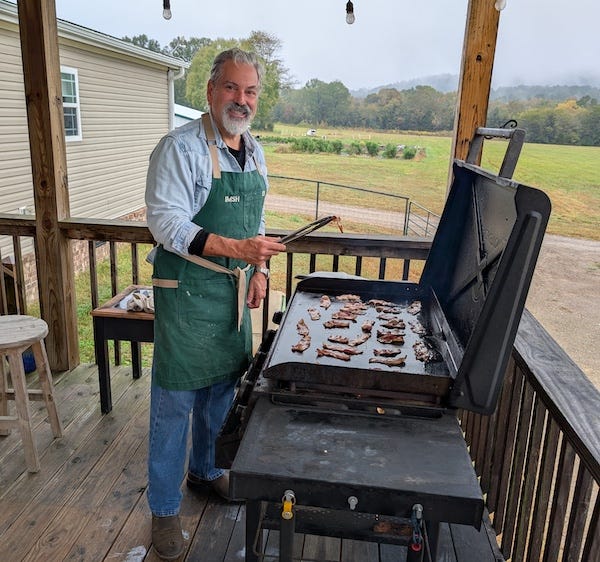
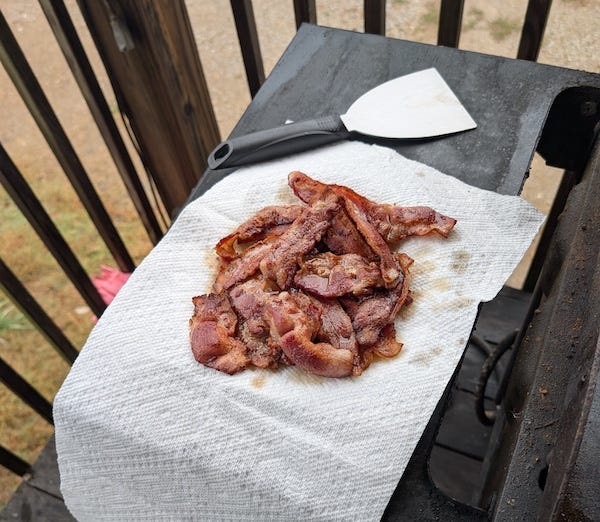

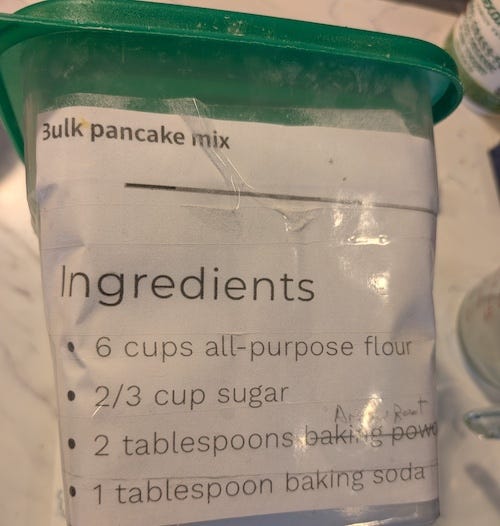
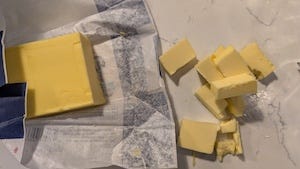

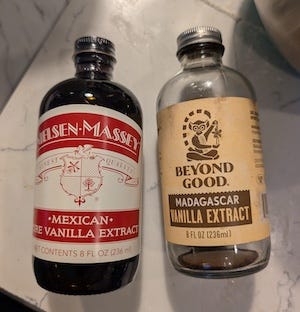


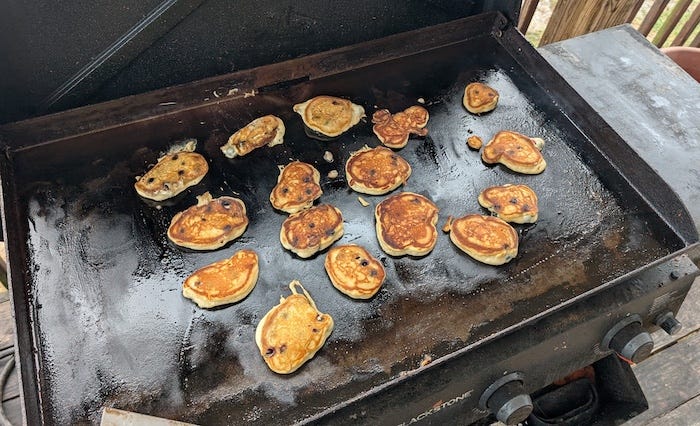
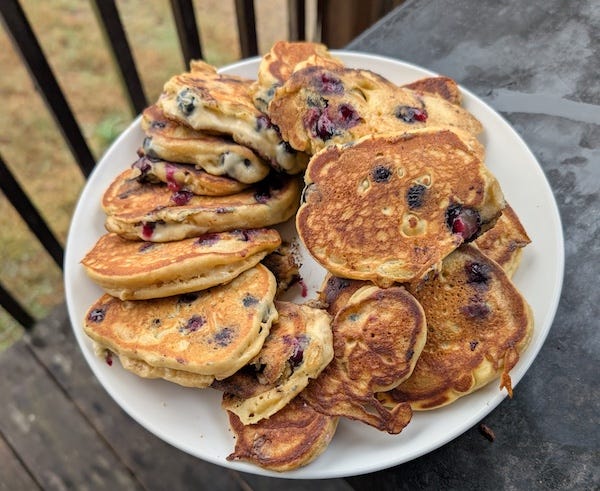
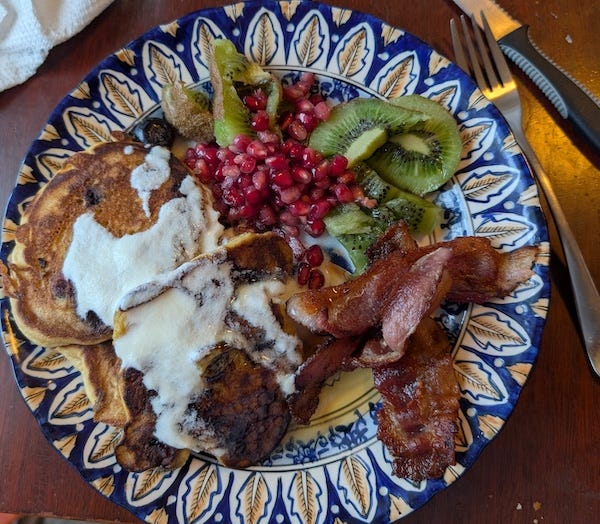
Dude! I still remember the best pancakes I ever had were on a backpacking trip in Colorado where we put the batter down in a cast-iron skillet over a fire and then sprinkled blueberries on top and some Kashi and then flipped them. A little butter after they were plated, and I was in heaven! I’ve never quite been able to create how awesome they were. But I still try every camping trip.
You certainly have a wonderful knack for explaining things clearly and concisely. Well done, Vinnie!